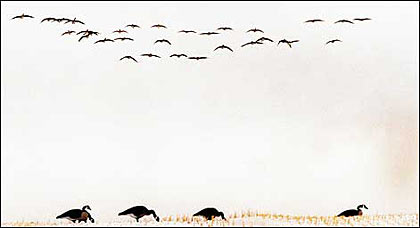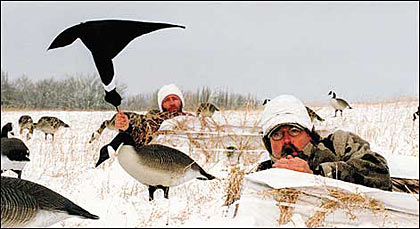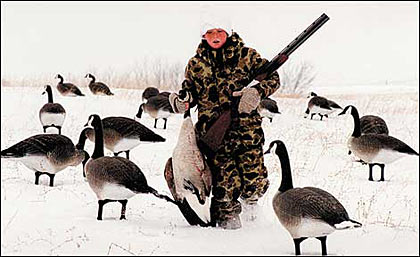November 03, 2010
Gunning Idaho's wary Canadas
 Ron places Big Foot decoys as the sun begins to light Idaho's Mount Bennett Hills. |
"Cluck, cluck, cluck, cluck, cluuuck, cluuuuuck," I pleaded through my goose call. Ron, nearby, kept busy wildly flapping a flag through the slit in his blind. Our rapid calling and flagging reached out to assure the in-coming Canadas that this field was the one to feed in. Wings, cupped but not totally committed, the leader of the flock craned its neck side to side, analyzing the spread with the precision of a Nobel Prize winning scientist. What had started out as a small speck miles on the horizon now hovered two hundred yards above our spread expecting us to make just the right sounds before he and his spooky group of feathered friends committed to landing.
Sinking deeper into my blind I couldn't help but chuckle at my predicament. I had traveled a long way to hunt ultra-wary geese. In fact, back home the season for resident geese had just started, and hundreds of untouched Canadas would be more than happy to keep our shotgun barrels warm.
Advertisement
Trying to further entice the flock leader, we changed from aggressive calling to contented clucks and low murmurs. Turning, two out of the group of 10 birds dropped their feet and coasted in for a landing as the rest of the flock flew away from the spread.
"Take 'em!" Ron cried out. I came up slapping my old semi-auto up to my shoulder and sending a load of BBs towards the surprised gander that was now wildly trying to back-peddle from a bad decision. Neatly folding, the goose came down with a satisfying thump. Quickly I brought the gun towards the other goose. A bit too far, I held my shooting long enough to see Ron's shot smack the bird and bring it down.
Advertisement
"Nice job," Ron said, as he stepped out of his blind to make the double retrieve. "It's nice to see we're not wasting any opportunity."
With spooky geese like these, Ron was right. We could not afford to waste any birds that came into range. Every shot had to count.
For several years, Ron Latschaw, former owner of Final Approach, had been talking with me about getting together and joining him on a hunt. With my sea duck guiding responsibilities making it hard to get away during the height of the hunting season, and Ron's equally busy schedule, a hunt together always eluded us. We finally had a small window of opportunity for a hunt. The only problem: Goose hunting season in Ron's home state was closed and the only place open for us to hunt was a 12 hour drive away in Idaho.
 A flock of ultra-wary Canada geese locked-on. |
Ron felt confident that we would get into geese. What he failed to mention was that these geese would be so spooky.
Picking me up at the Boise airport, Ron informed me that he had spent the previous day scouting geese along the Snake River. "Well, I did my homework. After scouting, I spoke to farmers in the area, and they said that geese were traveling the valley we were to hunt," he relayed.
Eager to use the rest of the day to plan the next morning's hunt, we made our way to the farms Ron had briefed me about.
Sure enough, we found about 600 geese feeding along a snow covered alfalfa farm. "If we're smart about what we are doing here, we can get a couple of days shooting," Ron blurted out like an excited kid out on his first hunt while he spied the feeding geese through his binoculars.
The next morning found us setting out decoys in the very spot where the geese had been feeding. With sunrise an hour away, the east winds were making the 10-degree temperature seem a bit colder. Keeping warm by putting out four-dozens of decoys and the blinds became a welcomed chore.
Wanting to see how the originator of the laydown blind would set out his rig, I paid close attention to Ron's setup. The most noticeable thing that stood out was the painstaking way he camouflaged the blinds. He draped them with a snow cover, and then grass was added to further match the surrounding area. With the field mostly blanketed with snow, some spots had a few clumps of yellow weed showing through. Ron would walk in the weed beds along the edge of the field, gathering handfuls of dried grass to place on the blinds. He made certain the blinds matched the area by putting these bits of weeds along its camouflaging straps.
Finally satisfied with the look of the blinds, Ron turned his attention to the way the decoys were set up. "I like to set my decoys in a butterfly pattern, with the blinds at the body area of the butterfly." I also noted that he placed a set of sentries outside of the rig and some near the blinds. He used the decoys to further break up the outline of the blinds.
By the time we were finally ready, the sun's golden glow was pushing its way over the Mount Bennett Hills. The low cloud cover off to the distance was threatening to stop any chance we had of the sun warming the day up.
The geese we were hunting that morning were to come out of the north, from the Minidoka National Wildlife Refuge, their roosting spot. Minidoka NWR is a favorite staging area for geese migrating south from Montana. With the miles of farmland the geese have to choose from, scouting is essential for a successful hunt. "You just can't go and set up anywhere," Ron stated.
After harvesting the two weary geese, Ron was careful to hide them. He then climbed back into his blind. Off in the distance we could see the geese coming out of the refuge in steady groups. Big flocks, small flocks, even the singles that came near our field flew high and passed us.
Then, out of nowhere, a single bird came in low from the right, Ron's side. Calling on my short reed call, I tried to sound like a contented flock of geese feeding the day away. Something worked because this Canada flew in committed. Thirty yards out, Ron came up and folded the bird.
After a wind shift and a quick change of the set up, it became obvious the bulk of birds were heading for parts unknown. "I hope they're not migrating--they're a mile high and heading south. That's not a great feeling," Ron said, sounding as disappointed as I was feeling.
It was time to call it a day and go scout for a new hunting spot. After a quick lunch, we drove several miles looking for flying or feeding geese. Without much success, we came upon a UPS driver making his deliveries along a sno
w covered farm road. After a quick chat with the driver, Ron came back to the truck with the good news. "He said there's a big bunch of geese about five miles from here."
 Calling and flagging as a group of geese fly towards the guns. |
Sure enough, after following the UPS man's directions, we found the geese. "Dam! There's a pile in there," Ron said while looking at the hundreds of feeding geese through his ever-present binoculars. After some investigative work locating the owner of the land and obtaining permission, we decided to spend the last few minutes of daylight watching to see what direction the geese flew to roost. Observing the geese and feeling good about prospects for the next day's hunt, our cheerful mood was dashed by a truck pulling up next to us. The driver was a local hunter who was part of a large group of hunters who were also planning to hunt the same field. We knew this had been too good to be true.
Not wanting to encounter any problems the following morning, Ron put a call to the group leader. "Hi there, this is Ron Latschaw with Final Approach Blinds," he began. "No, the same€¦. I'm not kidding." Ron explained to the surprised hunter on the other end. "You do? Well, I'm glad you like them." I assumed that the hunter used Ron's blinds and was happy with them--that's positive, I thought. "Well, were up here trying to get a goose hunt and found the geese you boys were planning to hunt as well. How about getting together and combining our efforts tomorrow?" Ron asked. We ended up getting an invite to hunt with the group. "I'm glad they like your blinds," I said to Ron with a smile.
Early next morning, a fresh covering of snow greeted us. Walking into the cold, not knowing what to expect--hunting with people you don't know can be a challenge. All we could do was hope for the best. Arriving at the field we had seen the hundreds of geese feeding on leftover wheat, we came upon a convoy. Two truck rigs pulling trailers full of full-bodied decoys, 20 dozen to be exact, dozens of shells, and several laydown blinds. These locals were serious about their goose hunting. The northeast wind made the 12-degree weather feel colder, as we all gathered for a quick strategy meeting. With eight hunters and three labs to hide, it was decided to hunt the edges of the draw surrounding the wheat field. Although not the exact spot where we had spied the geese the day before, our new hunting partners felt the geese would fly past their feeding grounds and land next to our decoys. Who was to argue, especially when they informed us that they had limited out doing the same thing the day before. At daybreak the geese came. Actually, they never stopped coming. After we all had limited out and started picking up the decoys, the geese were still coming and landing all around us. After a photo session, we planned out the next day's hunt.
Having a field that geese wanted to be in so bad, one would think there wouldn't be much to plan out. "The problem is that the season closed today on this side of the road," Ron explained. Apparently, our newfound goose magnet was to be a no hunting zone the following day. We decided to try a field on the other side of the road, even though these local hunters had never seen geese in it before. Graciously, our local experts suggested that it would be better to place a few blinds and take turns shooting. In a generous gesture, they also offered us first try in the blinds.
The next morning found us setting up a spread of decoys in the field across the road from where we hunted the day before. With several hunters to put out decoys and set up the blinds, getting ready was a quick affair. Ready by daybreak, we settled into the blinds to wait for the geese. In the blind next to me was Stratton Laggis, 12-year-old son of Paul. Very young, but with hunting experience, he was eager to harvest a goose. Stratton didn't have long to wait.
"I hear geese," I said to no one in particular. Quickly, Ron and I started calling. A lone goose made its way towards us from behind--a direction we didn't expect geese to be coming from. No hesitating, the committed Canada came right in. "Stratton, this is your bird, I told him. I watched the young hunter come up and pivot around. Quickly he brought his 12-gauge over and under shotgun, sending a load of BBs towards the scrambling goose and made a difficult shot behind him. I congratulated the young hunter. Happy with his goose, Stratton ran out to make the retrieve. Holding the bird, almost as big as he was, was a sight to see. Soon, his father Paul came up to switch him out of the blind with another hunter. Kelly Qualls of Nampa, Idaho was to join us in his first goose hunt. Stratton had a basketball game to play in. Not bad, twelve years old and already sneaking in a hunt before heading in to work, I thought. As son and father drove off, proud as could be, more geese could be heard making their way towards our hunting spot.
A flock of five approached from behind us. Ron and I started to work on the geese with our calls. Calling hard with aggressive clucking, the geese circled and worked their way to the front of the rig. Forty, 30, 20 yards out, "take 'em." We all came up shooting. Three nice geese stayed with us, ready to be retrieved.
 Idaho's Stratton Laggis, 12, makes a retrieve. |
Off in the distance more geese could be seen making their way towards our spot. Quickly, we hid the fallen geese and covered up in the blinds. Another dozen joined a group of 12, making for a large flock of spooky geese. Two hundred yards out and just as high, I was starting to get a feeling of deja'vu. Heavy gunning pressure put these geese on high alert.
As the flock made its third pass, we switched to feeding sounds. Dropping their feet, the large group of Canadas coasted into the landing spot we had left open in the decoys. The group came up shooting. Several geese folded in unison. With one goose left to fill Ron's limit, we didn't have long to wait. A lone goose came in from the stratosphere. Maple leafing from side to side, to quickly cut its altitude, the goose descended on our decoys. I kept busy on the call as we all watched the show. One shot by Ron folded the deceived goose twelve yards out from our blinds. A perfect ending to a great hunt. We quickly gathered our gear and switched out with the rest of the hunters.
Sitting in Ron's truck watching our new friends hunting across the road, while we snaked on goose jerky they provided, I couldn't help to think how fortunate we were to meet such friendly hunters.
Looking over Idaho's rolling hills--getting the opportunity to see such a historically rich area like the Oregon National Historic Trail used by fur traders, gold seekers, missionaries, and emigrants from 1841 to 1861--hunting near the famed Snake River, and pursuing such challenging geese, made this trip a memorable one. Topping it all off, it was great to see the hig
h level of sportsmanship that is prevalent in the waterfowling community. Meeting with strangers--who ended up becoming our friends made hunting for these ultra weary geese extremely worthwhile.
